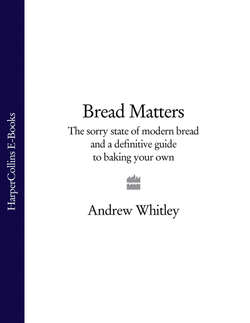Читать книгу Bread Matters: The sorry state of modern bread and a definitive guide to baking your own - Andrew Whitley - Страница 18
Milling methods
ОглавлениеBefore the invention of roller milling, all flour was produced by crushing wheat between revolving stones. All parts of the wheat – bran, germ and starchy endosperm – were pulverised and mixed together into what we know as wholemeal, or whole wheat, flour. If you wanted whiter flour, you had to sift the wholemeal through wire sieves or ‘bolting cloths’ made from cotton, linen or silk. The roller-milling system, deployed from 1870 onwards, was quite different. It passed the wheat between pairs of steel cylinders, which gradually stripped the layers off the grain, sifting the material thus produced into a series of streams, each containing a different fraction of the flour. These could be taken off and bagged separately or recombined to make ‘patent’ flours for various baking purposes.
Wholemeal flour is, in theory, the entire wheat grain (minus its husk) ground into flour. In British parlance, this is flour with a 100 per cent ‘extraction rate’: 100 per cent of the available flour or meal has been ‘extracted’ from the grain. White flour has only approximately 72 per cent of the content of the wheat, the remaining 28 per cent consisting of the bran layers on the outside of the grain and the germ tucked in one end. What used to be called ‘wheatmeal’ was about 85 per cent extraction. ‘Brown’ is a generic term describing flour of about 80 per cent extraction. Most of the vitamins and minerals are in the outer bran layers of wheat. In white flour milling, these are mostly sold for animal feed.
Wheat sold as breadmaking flour is more valuable in monetary terms to the miller than the residues that go to the animals. When it comes to nutritional value, however, the reverse is true. The table below shows what happens when whole wheat is milled to white flour9:
Vitamin and mineral loss during the refining of whole wheat to 70 per cent extraction white flour
The only word to describe bread made with such flour is ‘depleted’.
Whereas stone milling and sieving/bolting had generally produced a white flour consisting of 75-80 per cent of the original wheat, roller milling reduced this to 70-73 per cent. The visible effect was to produce a whiter flour with fewer flecks of bran in it. Far more important, however, was the reduction in the roller-milled flour of several important nutrients, including calcium, iron and B vitamins, which the stones had formerly dispersed throughout the flour. Removing the germ, which contains virtually all the valuable vitamin E of the wheat, was a nutritional disaster but a great benefit to the millers. The wheat germ oil tended to oxidise and go rancid within a few weeks. Without it, white flour could last for several months – exactly what was needed as milling companies became larger, with ever-longer distribution chains along the country’s fast-expanding network of railways and roads. Not for the last time, nutritional integrity was a casualty of the commercial need for ‘shelf life’. Some of the vitamin E, incidentally, goes to the supplement industry, which is happy to sell it back to us in capsules at many times what it might have cost us if we simply ate bread made with stoneground wholemeal flour.
In a French study in 2005, stoneground organic flour was shown to have 50 per cent more magnesium and 46 per cent more zinc than roller-milled non-organic flour10. This effect, it should be explained, was observed not in wholemeal but in flour milled to a finer extraction rate of around 80-85 per cent. Many people consume too little magnesium and the role of zinc in good health is well established. It would not be unreasonable to expect the benefits of organic growing (see page 43) and stone milling to apply similarly to other important micronutrients in flour.
The intriguing question is whether modern roller mills could be adapted to deliver flour with the same nutritional integrity as stoneground. It is hard to believe that the technological ingenuity would be lacking. But commercial will is quite another matter. The track record of the big milling concerns does not suggest a major commitment to the nutritional quality of their flour. Milling technology is currently focused on the functional effects to be had from producing ever finer fractions of flour.
In 1941 nutritional scientists persuaded the government to force a reluctant milling industry to add calcium to its white flour. Three other nutrients (iron, vitamin B1 and nicotinic acid) were added in 1953 – although in lower amounts than would be found in wholemeal flour. All the other deficiencies and differences between stoneground and roller-milled and wholemeal and white flours listed above remain.
Official advice does now stress the importance of whole grain cereals in the diet. However, almost all the ‘whole’ wheat flour produced today is from roller mills. In other words, it is reassembled from the separated fractions of flour but without the crucial wheat germ oil, on the grounds that replacing it would shorten the flour’s shelf life. Perhaps such flour should be labelled ‘reconstituted semi-whole wheat flour’ to alert consumers to the fact that it does not contain all the elements of the original grain.
